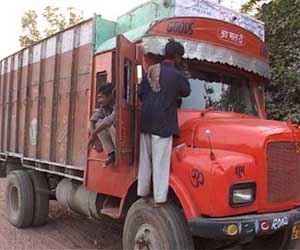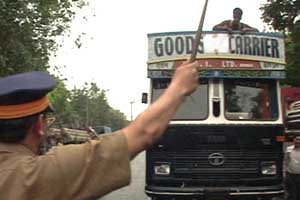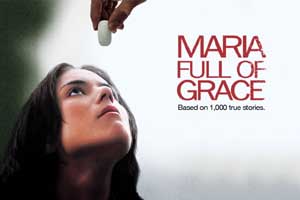Focused on the fringes: Graduate student, alumnus expand terrain covered by film
By Silpa MaruriNews Office
     | |
In the tradition of such independent filmmakers as Chicago alumni Kimberly Peirce (A.B.,’90) (Boys Don’t Cry) and Philip Kaufman (A.B.,’58) (The Unbearable Lightness of Being, Henry and June, Quills, Invasion of the Body Snatchers and The Right Stuff, among other films), two new filmmakers—one current student and one alumnus—are documenting areas often ignored by mainstream culture, expanding the terrain covered by film.
Both Bulbul Tiwari and Josh Marston say they aspire to represent commonly misunderstood aspects of reality to reflect an honest portrait of the people behind monolithic myths.
For Tiwari, this aspiration has led to Carriers, a documentary about the despised truck drivers of India. For Marston, the desire to expose misconceptions has led to a portrait of life as a drug mule in Maria Full of Grace. In their different capacities, both filmmakers are winning acclaim for the honest portrayals they present in their work.
For Tiwari, the decision to document India in the form of film ties directly to the journey she took through academia. As the child of an Indian diplomat, Tiwari spent her youth traveling the world. She attended high school in Singapore and came to the United States to attend Harvard University in 1995, where she majored in French and English literature.
She toyed with the idea of entering into journalism, and in particular, TV news. It was not until her third year, when she took her first filmmaking class, that Tiwari discovered she wanted to be a filmmaker. After graduation, she worked in New York for a short period in a film production company. In 2000, she journeyed to India for six months to be the assistant director of the documentary Flight to the Future.
By 2001, Tiwari’s interest in film led her, not to film school, but instead to graduate studies in South Asian Languages & Civilizations at Chicago. Tiwari says the pursuit of a Ph.D. in South Asian Studies ties directly to her filmmaking interests and her culture. “I still think of myself as an Indian. It’s my muse and my inspiration. And also, I really feel like it’s an area that needs a new filmmaker.”
At Chicago, Tiwari began to delve into ancient Sanskrit texts, such as the Mahabharata, and wrote a play based on the text, which University Theater performed in 2002. In this early work, titled The Egg, Tiwari explored the relationship that contemporary society holds to mythology and the ancient.
Carriers, which explores the realities of contemporary India by recording the lives of four truck drivers in India, seeks to dispel the stereotypes surrounding these lower- middle-class men. Tiwari says her earlier work is linked to her most recent project because of the way they delve into how mythology interacts with modern life. “Storytelling is an essential part of personal and national narratives. These truck drivers imagine themselves as a separate caste in India. They even have invented their own mythology about how they came to be drivers, about a curse sent down from God.”
When asked what motivated her to do a film about Indian truck drivers, Tiwari explains, “Truck drivers in India are considered outcasts and criminals. There is a lot of prejudice against them. They suffer from very high rates of HIV infection.” Her film is an effort to give these workers representation within the media for the first time by providing a portrait that is simultaneously honest and positive, she says.
Dipesh Chakrabarty, the Lawrence A. Kimpton Distinguished Service Professor in South Asian Languages & Civilizations and the College, supports his student’s social critique. “India needs more of this. The more we have of appreciation and criticism by people who are tied to her and yet distant from the country, the better for an India that wants to be a part of a global community. At the same time, observers from outside need to be in touch with India for the communication to be effective.”
To complete the film, Tiwari spent two months traveling in India. She relates the difficulties in communicating with the drivers because of the gender and social station differences between her subjects and herself. “Traditionally, truck drivers only know women to be wives, mothers and prostitutes. It was very unusual for these men to be confronted by a professional woman. Some did not think certain things were suitable to say to an upper-class woman.”
During one interview, Tiwari admits she was taken aback when two male subjects turned the conversation toward sex. “There was nothing obviously frightening, but the general undertone made me uncomfortable. They would say things like, ‘Oh, you’re not married. You don’t look 26.’” Despite this experience, Tiwari relates that her overall experience was positive, and notes that “some of the men were very shy and nice.”
In order to finance the production, Tiwari had to raise the funds herself, dipping into her own stipend and scholarship money, and relying on a private financier. Often, the people who worked with her, such as her assistant manager, accepted a pay cut to ensure completion of the project.
The film attempts to give a voice to an ignored population, one often misrepresented by the mainstream media, by allowing that population to speak for itself. She hopes their voices will be heard and perhaps even influence current perceptions. “Maybe powerful Indians will see it. Maybe the middle class will change their opinions because of it.”
For Marston, making a film about another misunderstood group led him from California, where he attended the University of California at Berkeley, to photojournalism internships with Life magazine and ABC News, to Chicago, where he studied Political Science (A.M.,’94), and then to New York University to study filmmaking. While at NYU, Marston discovered a fusion of the visual and the political, in the form of film.
Marston wrote two short films, Bus to Queens and Trifecta, but it was his experiences after graduating from film school in 1998, which spurred him toward creating Maria Full of Grace. After meeting a Colombian woman who worked as a drug mule in Queens, Marston began researching Colombia and U.S. drug policy. He then drafted his first version of Maria Full of Grace, developing his central character, a pregnant teen-ager who becomes a drug mule to escape the cramped conditions of her life as a flower factory worker.
Marston traveled to South America and Central America to research his subject matter and interviewed plantation workers and prison inmates who had previously traveled as drug mules. Two years later, he had the script completely rewritten and translated to Spanish. The end product of this work is a film that won the 2004 Sundance Film Festival Audience Award. Though fictional, the film is widely lauded for its strong feeling of reality. One critic even stated, “Maria Full of Grace often has the feel of the very best documentaries.”
Marston strove to maintain authenticity throughout the writing and filming of the project, hiring native Colombians and Colombian-Americans to play roles based on their own lives.
He told the Web journal offoffoff.com, a guide to alternative arts in New York, that “what I was interested in doing was not telling a story that we’ve seen already from the top down&from the point of view of the DEA agent or the drug trafficker&but telling it from the bottom up, from the point of view of someone fairly low on the totem pole who is suffering through this experience. And in that way, I wanted to make it not so much ‘matter-of-fact,’ but everyday.”
The film was shot in Spanish with English subtitles in South America and parts of Queens. So real is its content that the First Lady of Colombia is using the film as educational material to deter drug smuggling.
Both Marston and Tiwari are doing the work of independent filmmaking, presenting unconventional perspectives to a world audience. The products of their aspirations are two films that allow the people who are caught up in two misunderstood worlds to tell their own stories.
![[Chronicle]](/images/sidebar_header_oct06.gif)